3bolt79
Moderator
- Joined
- Jun 28, 2024
- Messages
- 406
- Reaction score
- 799
All right, first remove you strings.
The get the neck as straight as possible, using a notched straight edge with the finger board touching all points of the straight edge between the frets. Or, if you don’t have a notched straight edge, use a ruler and make sure that all frets are touching the straight edge from the first fret, to the end of the ruler.
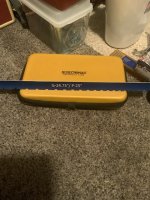
Now is a good time to check if the frets are level with a rocker. Tap down any high frets with a rubber hammer. After that, it’s a good time to oil the fretboard.
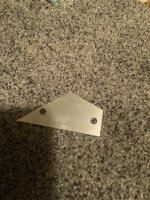
Check 3 frets at a time with the rocker or a credit card. If the fret rocks out of the three that you are checking, the fret in the middle of the three is the culprit. Tap it town. Check the edges of the fretboard near the high and low E strings and check in the middle between the D and G strings. Once that is done, oil the board. Put a few drops of oil on a cotton rag and wipe the wood. Allow it to soak in for a few minutes and wipe off the excess. If the board is really dry, repeat the process. Don’t over oil the wood. It should be darker than you started, with a light sheen after you’ve wiped off the excess.
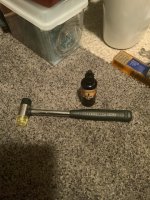
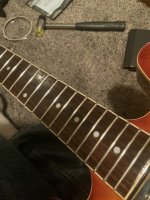
Next, install your strings. One wrap over and one wrap under is sufficient for the low E and A strings.
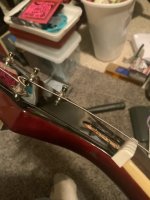
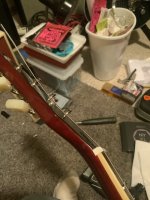
For the D string, you want one wrap over, and 2 to 3 wraps under the tail. This pinches the string and reduces slippage, and eliminates the need for a “Luthier’s knot.”

For the plain steel strings, you wrap them in reverse. It’s easiest to start from the high E, going to the B, and then the G strings. You want 5 to 7 wraps below the tail on the high E and B strings and at least 3 to 5 on the G string. This helps with attaining the proper break angle from the nut to the tuning peg, and makes for more stable tuning.
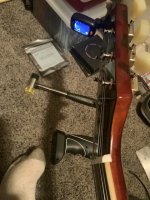
Adjusting action and intonation.
Adjust the action/stringheights first. On an Epiphone, you can turn the slots in the posts with a flat head screwdriver. On a Gibson, you will have to adjust the thumb wheels.
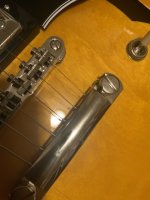
Set the height at 4/64 at the 14th fret on the high E and 5/64 at the 14th fret on the Low E to start. Adjust from there to taste.
Intonation.
Check the open string notes and compare them to the 12th fret fretted note. If the fretted note at the 12th fret is sharp, lengthen the string by moving the saddle toward the tailpiece, by turning the adjustment screw on the saddle with a small, flat head screwdriver. If the fretted note at the 12th fret is flat, compared to the open string, move the saddle toward the nut.
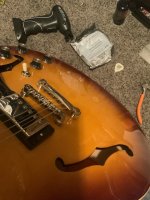
Now, lastly, with the guitar tuned to pitch, see if you can barely slip a business card Uber the 6th fret, with a capo at the first fret, and the low E depressed at the fret where the neck joins the body. If you are using 10-46 gauge strings, it should be fine. If you are using 11-48/49, or a set of 12’s, you may need to check the neck relief and tighten the truss rod to get the proper relief. Then, check your action and intonation again.
For the truss rod adjustment on an Epi, you will need a 4mm Allen Wrench, on a Gibson, use the truss rod tool that came with the guitar. The Gibson will have a nut, and it is Standard size. Most SAE sockets and nut drivers are too big to get in the hole to turn the nut, so use the Gibson tool that came with the guitar.
The get the neck as straight as possible, using a notched straight edge with the finger board touching all points of the straight edge between the frets. Or, if you don’t have a notched straight edge, use a ruler and make sure that all frets are touching the straight edge from the first fret, to the end of the ruler.

Now is a good time to check if the frets are level with a rocker. Tap down any high frets with a rubber hammer. After that, it’s a good time to oil the fretboard.

Check 3 frets at a time with the rocker or a credit card. If the fret rocks out of the three that you are checking, the fret in the middle of the three is the culprit. Tap it town. Check the edges of the fretboard near the high and low E strings and check in the middle between the D and G strings. Once that is done, oil the board. Put a few drops of oil on a cotton rag and wipe the wood. Allow it to soak in for a few minutes and wipe off the excess. If the board is really dry, repeat the process. Don’t over oil the wood. It should be darker than you started, with a light sheen after you’ve wiped off the excess.


Next, install your strings. One wrap over and one wrap under is sufficient for the low E and A strings.


For the D string, you want one wrap over, and 2 to 3 wraps under the tail. This pinches the string and reduces slippage, and eliminates the need for a “Luthier’s knot.”

For the plain steel strings, you wrap them in reverse. It’s easiest to start from the high E, going to the B, and then the G strings. You want 5 to 7 wraps below the tail on the high E and B strings and at least 3 to 5 on the G string. This helps with attaining the proper break angle from the nut to the tuning peg, and makes for more stable tuning.

Adjusting action and intonation.
Adjust the action/stringheights first. On an Epiphone, you can turn the slots in the posts with a flat head screwdriver. On a Gibson, you will have to adjust the thumb wheels.

Set the height at 4/64 at the 14th fret on the high E and 5/64 at the 14th fret on the Low E to start. Adjust from there to taste.
Intonation.
Check the open string notes and compare them to the 12th fret fretted note. If the fretted note at the 12th fret is sharp, lengthen the string by moving the saddle toward the tailpiece, by turning the adjustment screw on the saddle with a small, flat head screwdriver. If the fretted note at the 12th fret is flat, compared to the open string, move the saddle toward the nut.

Now, lastly, with the guitar tuned to pitch, see if you can barely slip a business card Uber the 6th fret, with a capo at the first fret, and the low E depressed at the fret where the neck joins the body. If you are using 10-46 gauge strings, it should be fine. If you are using 11-48/49, or a set of 12’s, you may need to check the neck relief and tighten the truss rod to get the proper relief. Then, check your action and intonation again.
For the truss rod adjustment on an Epi, you will need a 4mm Allen Wrench, on a Gibson, use the truss rod tool that came with the guitar. The Gibson will have a nut, and it is Standard size. Most SAE sockets and nut drivers are too big to get in the hole to turn the nut, so use the Gibson tool that came with the guitar.
Last edited: